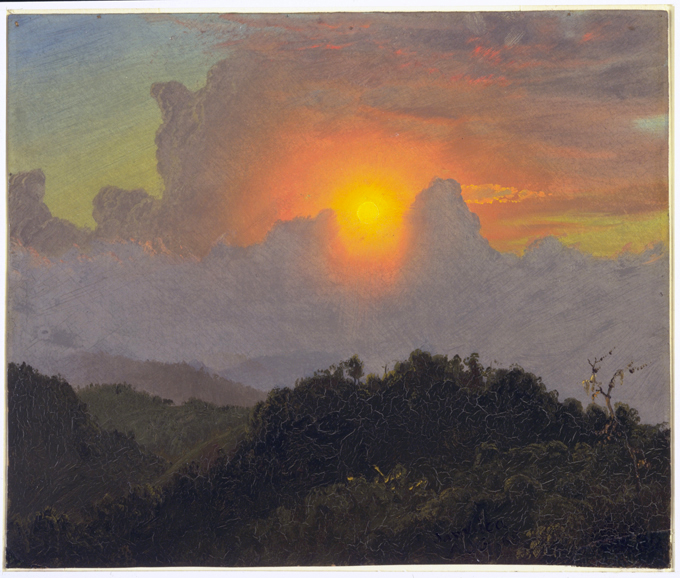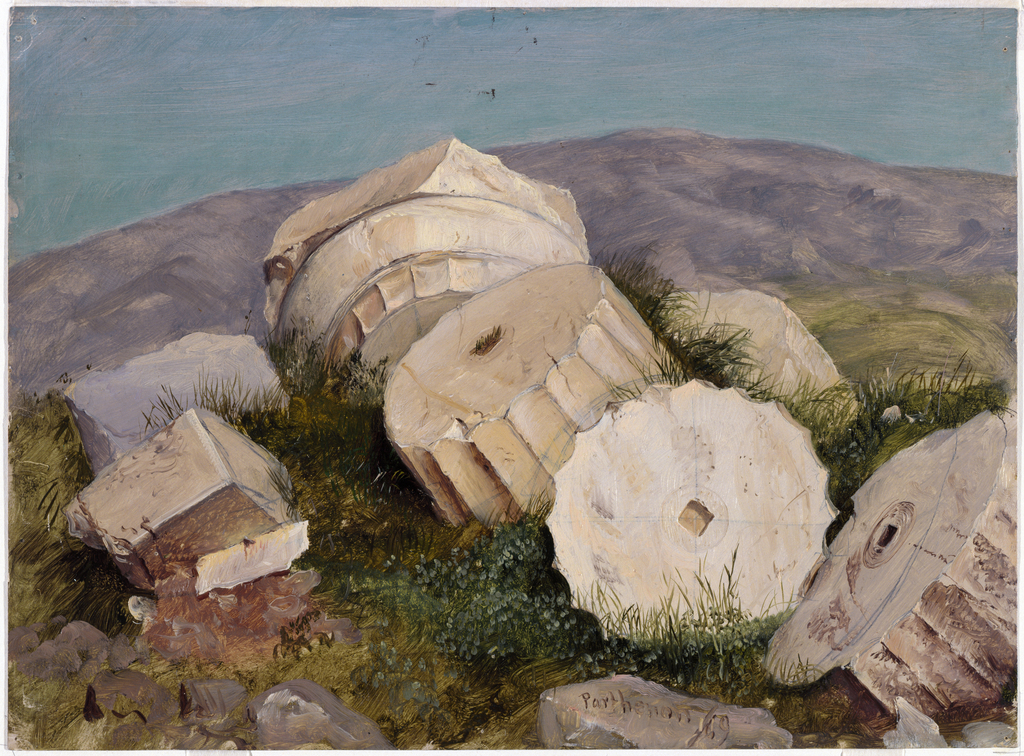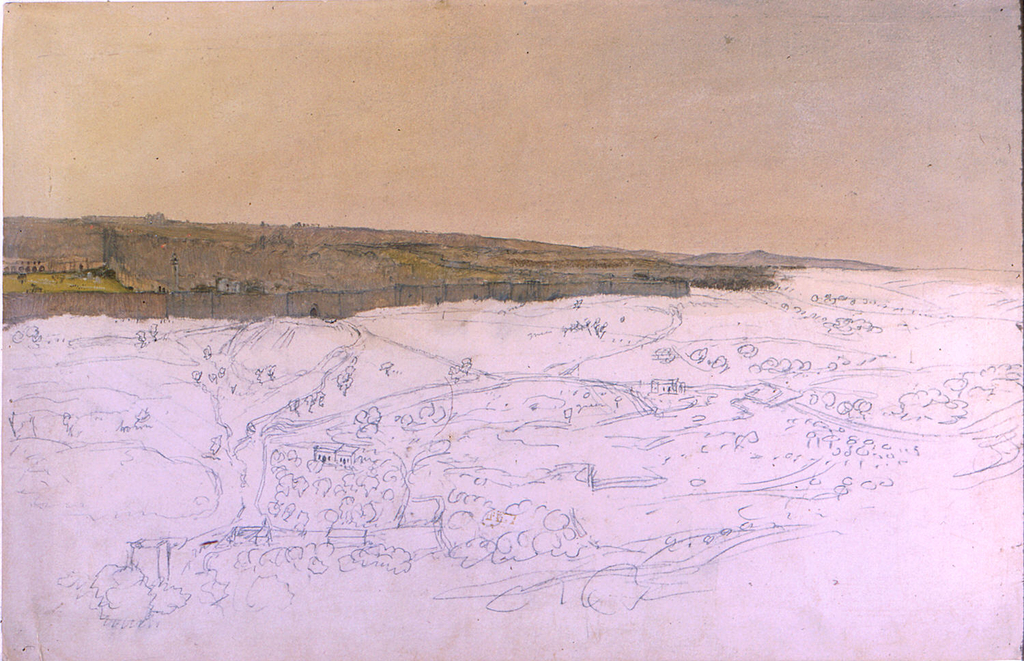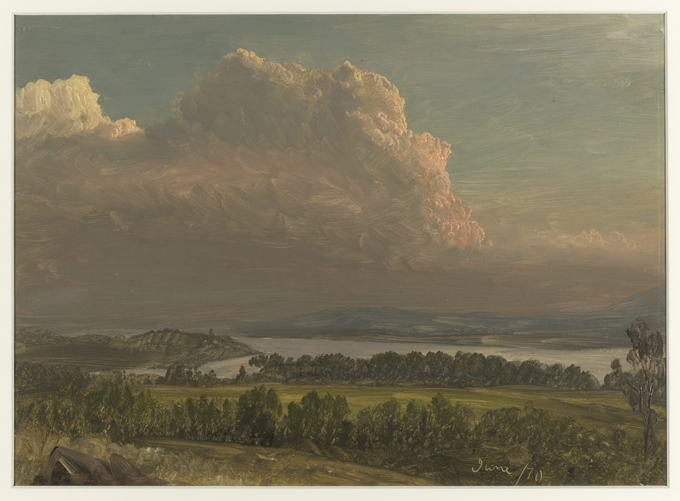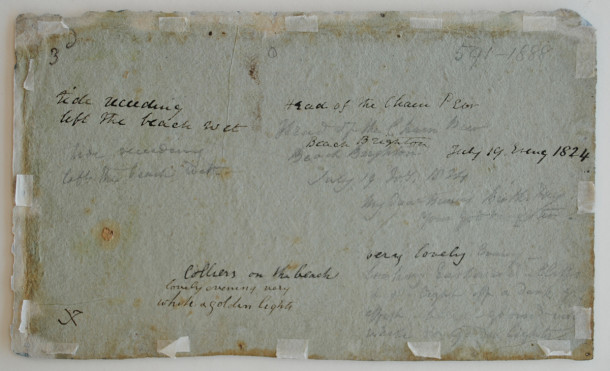Viewing: Blog Posts Tagged with: the rules they are a-changing, Most Recent at Top [Help]
Results 1 - 25 of 96
Blog: Stef's sketches (Login to Add to MyJacketFlap)
JacketFlap tags: California, plein air painting, architecture, Gouache, los angeles, highland park, acryla gouache, Add a tag
Blog: Stef's sketches (Login to Add to MyJacketFlap)
JacketFlap tags: California, plein air painting, architecture, Gouache, los angeles, gouache painting, acryla gouache, miracle mile, petersen automotive museum, Add a tag
Gouache painting of the Petersen Museum last weekend.
Blog: Gurney Journey (Login to Add to MyJacketFlap)
JacketFlap tags: Video, Portraits, Watercolor Painting, Plein Air Painting, Add a tag
Yesterday Jeanette and I decide to try out an experiment.
It's the day before graduation at Bard College. Students are roaming around campus with their parents. We place the typewriter on a table in the student center, and I arrange the sketch easel.
We hope the typewriter will lure someone to pose for an impromptu portrait. First Cullan, and then his mom, try it out.
We set up the iPad to webcast the action via Facebook Live. The first session has audio issues due to problems with our old iPad (sorry). We switch over to an Android cellphone, and then it works fine. Here's the 16 minute webcast. (Link to video).
I start sketching Jeanette, but abandon the start and turn the page when Kathleen sits down. I lay down a few lines in watercolor pencils, then launch off with brush and watercolor to place the main shapes. With progressively smaller brushes, I place the smaller details.
 |
| Kathleen, watercolor and gouache |
Subscribe and follow and you won't miss a future webcast.
GurneyJourney YouTube channel
My Public Facebook page
GurneyJourney on Pinterest
JamesGurney Art on Instagram
@GurneyJourney on Twitter
Blog: Gurney Journey (Login to Add to MyJacketFlap)
JacketFlap tags: Plein Air Painting, Add a tag
Blog: Gurney Journey (Login to Add to MyJacketFlap)
JacketFlap tags: Plein Air Painting, Gouache, Add a tag
My car is in the shop for new tires. It's too cold to paint outside, so I set up by the coffee machine. The car goes up on the lift. An impact wrench rattles. I've got about an hour.
 |
| Van Kleeck's Tire, Gouache, 5 x 8 inches, 1 hour |
This video shows a few stages of the process. (Sweater vest by Jeanette) (Link to the video on YouTube).
I set up a warm foreground and a cool background, going quite dark in the transition between them. The cool note of the computer screen in the near office was an exception to the warm foreground, like a dot on a taijitu.
I invent the color statement to add depth and mood. The actual scene is more evenly lit with uniformly colored fluorescent lights.
----
If you've been thinking of getting into Guerilla Gouache, there's no time like the present. Here's all you need to get started:
Pentalic watercolor sketchbook
Holbein gouache set
Richeson travel brush set
And join the GurneyJourney on Instagram, Pinterest, Facebook, Twitter, and YouTube.
Blog: Gurney Journey (Login to Add to MyJacketFlap)
JacketFlap tags: Plein Air Painting, Add a tag
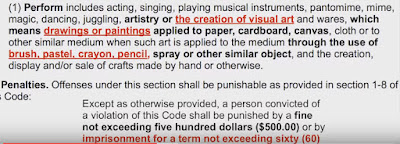
I asked Roger Bansemer, an outdoor painter who lives in Saint Augustine, for his views on this law. Roger and his wife Sarah host a nationwide show "Painting and Travel with Roger and Sarah Bansemer" on PBS (Public Broadcasting Service).
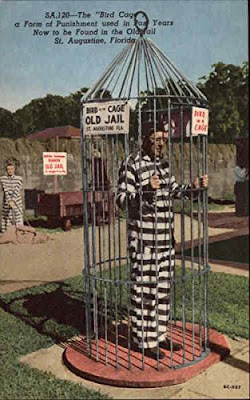
Bansemer: Shop owners complained because artists were taking up space in front of their businesses, but the bigger problem was that artists felt they had the "right" to set up shop on the street or park and commercially sell their paintings. So the artists in many respects were to blame for what has happened. When artists were allowed to sell their paintings, others felt they had the right to do the same so people began selling sun glasses and so on. It became a problem especially to those shop owners who pay high rents to have space usurped in front of their stores. Painting in public is one thing, but setting up a dozen paintings for sale around your feet is something else and the city has the right to limit that type of activity.
JG: What advice would you give to artists who want to paint in popular or crowded tourist areas?
RB: Don't make your plein-air painting experience into a selling venue. You'll ruin it for everyone. Position yourself where you won't block shop owners' window displays or entrances where tourists gather to watch you. Be professional, which includes being tidy even down to what you wear. Don't make your plein-air painting a personal showcase of you or your work.
JG: Do you have a message for merchants or town governments who have similar concerns?
RB: Tourists love to watch artists at work. Businesses should realize that an artist quietly working at one painting at his/her easel will attract business and add to the artistic flavor of the community. Here in St. Augustine at the town square, you can get up on the pavilion and give a speech but can't quietly paint that same pavilion. It doesn't make sense.
----
YouTube trailer for Roger's program: "Painting and Travel" on PBS
Article: St. Augustine Has Outlawed Art, And You Should Know About It
Article: When Outdoor Painting is Illegal
Facebook Group: Illegal Paintings of Park Avenue
Blog: Gurney Journey (Login to Add to MyJacketFlap)
JacketFlap tags: Plein Air Painting, Painting Gear, Add a tag
 |
| Street painting in Hudson, New York. |
The safety triangle sits on a weighted base and the triangle pieces fold down. I cut the "Department of Art" stencil to customize the traffic cone. You can also wear a reflective safety vest
Blog: Gurney Journey (Login to Add to MyJacketFlap)
JacketFlap tags: Plein Air Painting, Gouache, Paint Technique, Add a tag
In this new YouTube video, I demonstrate a useful principle that will help you with speed and accuracy in plein-air painting. (Link to YouTube)
I do a study of an excavator in gouache (opaque watercolor), using big brushes and big shapes at first, and then I finish with smaller brushes, spending time only on the details that interest me the most. The whole study took about two hours, but it gave me essential information as I developed the design for the giant robot.
Digital download from Gumroad (HD MP4)
DVD (NTSC Region 1):
Blog: Gurney Journey (Login to Add to MyJacketFlap)
JacketFlap tags: Plein Air Painting, Lighting, Add a tag
 |
| Micronesia foliage from U.C. Berkeley |
 |
| James Perry Wilson, Summery Showers |
Blog: Gurney Journey (Login to Add to MyJacketFlap)
JacketFlap tags: Plein Air Painting, Casein Painting, Color, Add a tag
At sunrise I'm standing at the bottom of an entrance ramp leading down into a parking lot in Kingston, New York. It's not a place that tourists would ever go.
I limit my casein colors to three (plus white): raw umber, golden ochre, and cobalt blue. The underpainting of tinted Venetian red adds a contrasting hue. (By the way, using a contrasting colored underpainting is a legal way to sneak in an additional color in the "Outdoor Market Challenge.)
Blog: Gurney Journey (Login to Add to MyJacketFlap)
JacketFlap tags: Video, Color, Plein Air Painting, Paint Technique, Add a tag
You can make a limited palette out of almost any two colors, as long as one is cool and the other is warm.
 |
| Catskill Roadhouse |
Blog: Gurney Journey (Login to Add to MyJacketFlap)
JacketFlap tags: Plein Air Painting, Gouache, Add a tag
(Link to video on YouTube) Here's a brief YouTube version showing the winter landscape at sunset. It's just a fraction of the entire segment from "Gouache in the Wild."
I had to wait for a day that was just above freezing. Before leaving on the painting trip, I prepared a page of the book with a casein underpainting— a warm color area surrounded by cool colors. I had a vague idea of using that abstract color field for some subject that I could light selectively.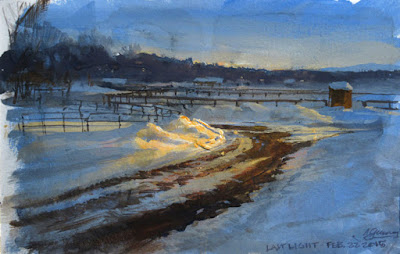
The casein underpainting presents a closed surface to the gouache, so it won't pick up the wet washes, and it makes the watercolor paper a little less absorbent. But the best part is that the color field suggested possibilities for the overlaying washes of semi-opaque color.
---
Own the whole video and take part in the fun
• HD MP4 Download at Gumroad (GurneyJourney readers get 10% off all Gumroad products this week only at this link) $14.95 This week only $13.45
• or HD MP4 Download at Sellfy (for Paypal customers) for 10% off this week only
• DVD at Kunaki.com 10% off this week only—$24.50. This week only $22.00
(Ships anywhere worldwide. Region 1 encoded NTSC video)
Blog: Gurney Journey (Login to Add to MyJacketFlap)
JacketFlap tags: Plein Air Painting, Academic Painters, Add a tag
 |
| Fidelity Bridges, Milkweeds, 1876. Watercolor and gouache on paper |
"She soon became a familiar village figure, tall, elegant, beautiful even in her sixties, her hair swept back, her attire always formal, even when sketching in the fields or riding her bicycle through town. Her life was quiet and un-ostentatious, her friends unmarried ladies of refinement and of literary and artistic task who she joined for woodland picnics and afternoon teas."
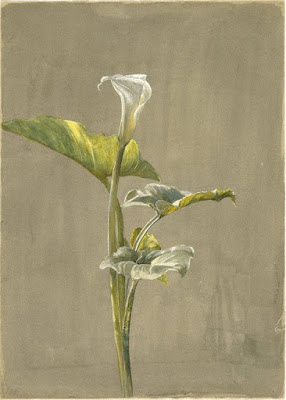 |
| Fidelia Bridges, Calla Lily, 1875 |
Blog: Gurney Journey (Login to Add to MyJacketFlap)
JacketFlap tags: Plein Air Painting, Hudson River School, Add a tag
 |
| William Trost Richards, Into the Woods, oil/canvas, 1860 |
Blog: Gurney Journey (Login to Add to MyJacketFlap)
JacketFlap tags: Plein Air Painting, Hudson River School, Add a tag
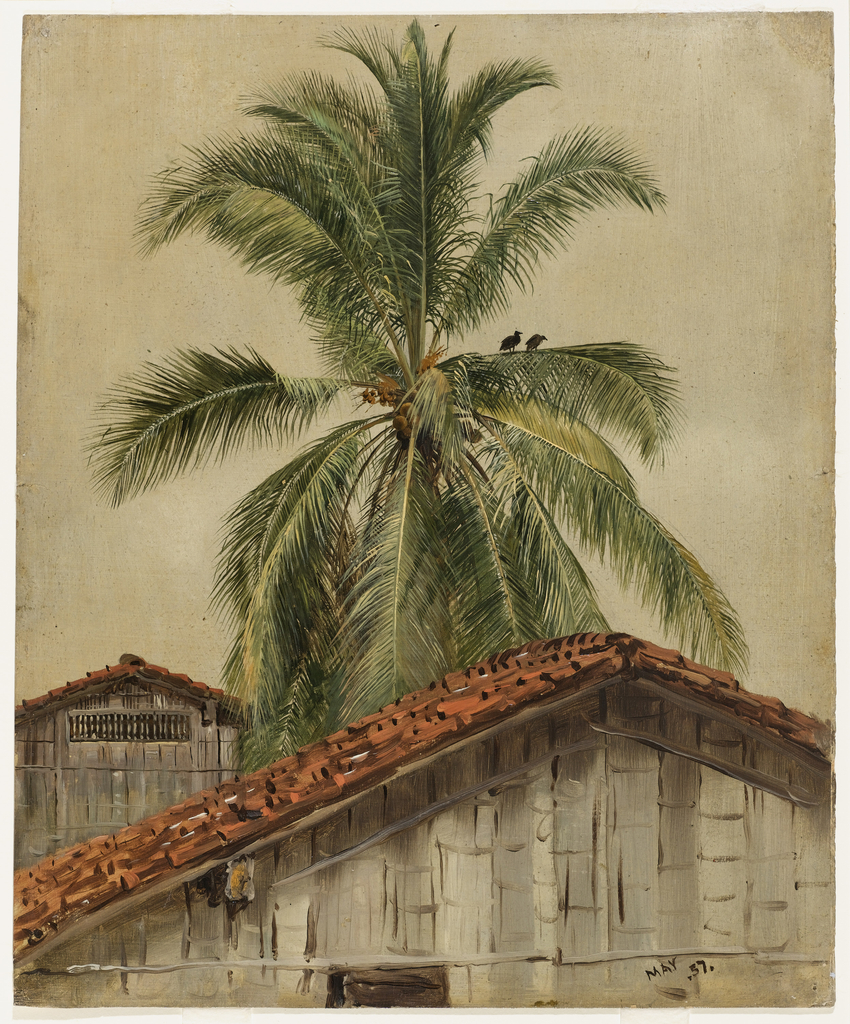 |
| Frederic Church, Palm Trees and Housetops, Ecuador, May 1857, Cooper Hewitt |
 |
| Frederic Church Trees with Vines, Jamaica, 1865, Cooper Hewitt |
• There's a book: Frederic Church and the Landscape Oil Sketch (National Gallery London)
• You can survey the sketches online at the Cooper Hewitt's Frederic Church Sketch Collection. They deserve credit for making the images available to students and scholars.
Blog: Gurney Journey (Login to Add to MyJacketFlap)
JacketFlap tags: Plein Air Painting, Academic Painters, Painting Gear, Add a tag
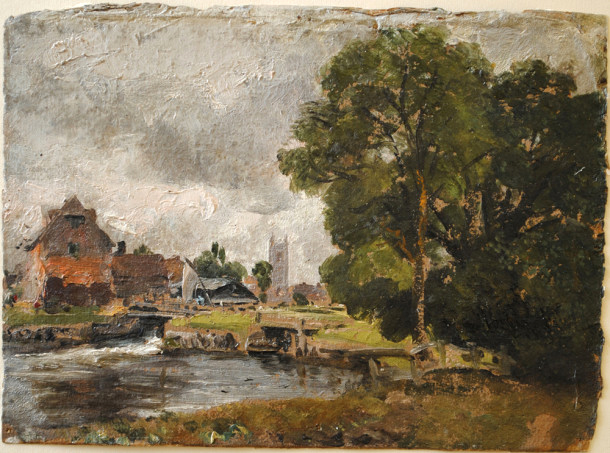 |
| Constable, Dedham Lock and Mill, 1811, courtesy VAM. |
Paint Boxes
Here is one of Constable's surviving oil sketch boxes. The glass vials were a way to carry medium and pigment, as tubed paint didn't come along until 1841. Another way to carry mixed paint was the urine bladders from pigs or other animals, something you could pick up from a butcher.
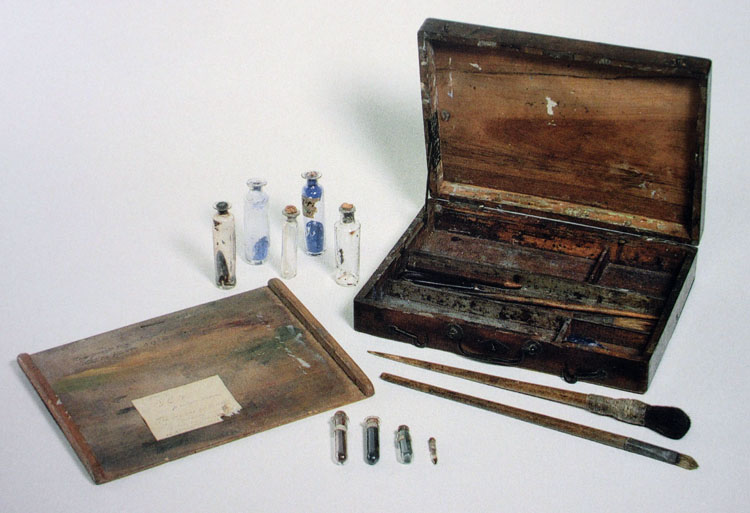 |
| One of Constable's wooden sketching boxes, 9.25 x 12 inches. |
I don't know if I would agree with the authors that wet sketches were "piled in" to such a box. My guess is that Constable would have used a box like this open in his lap with the lid away from him as he sat on a tripod stool. The sketch would be pinned into the open lid, and kept pinned there until it was dry enough to handle. This was how Americans, such as Thomas Cole, Albert Bierstadt, and William Trost Richards did it.
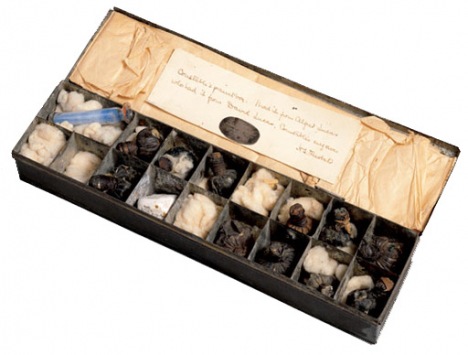 |
| Constable's Paint Box c. 1837, courtesy Tate Gallery |
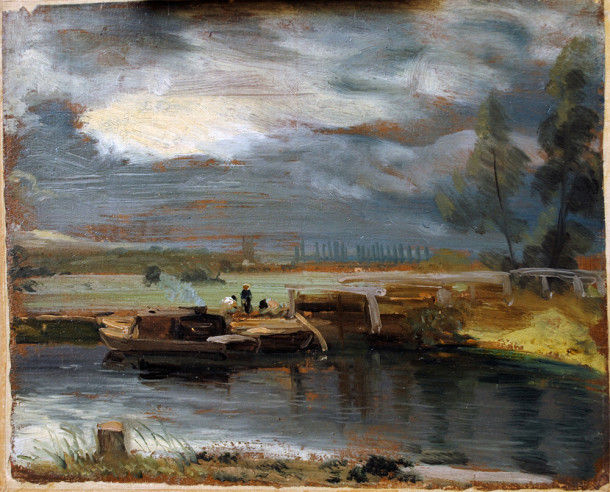 |
| Constable plein-air study showing red-brown colored ground |
Surfaces
Constable's studies were usually painted on heavy paper or millboard. Millboard was made from a mixture of cotton, flax, wood, and other fibrous material. The priming was a "viscous medium-rich oil ground containing a small amount of red and black pigment." (Source)
The priming, prepared in batches in advance of his painting sessions, saturated and sealed the sheets. I couldn't tell from my research whether he sized his surfaces before applying the oil ground. Later painters typically sized (or sealed) the paper or board with shellac or rabbit skin glue. By the 1820s, Constable was using commercially-prepared millboard or "Academy board," which was specially made for artists.
(With modern materials, I would use acrylic matte medium
One of his surviving plein-air palettes was analyzed for paint ingredients, including vermilion, emerald green, chrome yellow, cobalt blue, lead white and madder, ground in a variety of mediums such as linseed oil mixed with pine resin.
 |
| Constable sunset study, probably painted all in one session (or alla prima) |
At times it can be hard to tell whether a given sketch was done entirely on location or whether he touched them up after returning to the studio. Chemical sleuths have found that some sketches contain slow-drying mediums, such as poppy oil, which would have allowed him to rework his surfaces over extended periods of time, but that doesn't prove anything. To my eye, based on the efficiency and urgency of the paint handling, the ones shown in this post look to be done entirely on location.
Written Notes
Constable often jotted notes on the back of his paper or boards. For example: "Very lovely evening—looking Eastward—cliffs (and) light off a dark grey sky –effect-background-very white and golden light."
Sources and further reading
Books: Constable's Oil Sketches 1809-29
The Painted Sketch: American Impressions From Nature, 1830-1880
Websites: Constable Sketches Up Close and Personal (Victoria and Albert Museum, London)
Constable's Techniques (Tate Museum, London)
Lines and Colors Blog "Constable's Oil Sketches"
Constable paintings at the Yale Center for British Art
Blog: Gurney Journey (Login to Add to MyJacketFlap)
JacketFlap tags: Plein Air Painting, Add a tag
Here's the painting in gouache, which took about an hour from start to finish. I streamed with an iPad2 using BUSK, Concert Window's streaming app for iOS smart phones and tablets.
This is the prototype iPad holder that I built. It's made of plywood and a piece of picture frame. But it's not adequate because it doesn't protect the iPad enough from a fall risk. I'll build an improved prototype and share that with you.
| iPad holder for a camera tripod |
We were just testing this out, really, so we didn't announce, schedule, or promote the show. But the word mysteriously spread, and 53 viewers magically found their way to the stream. There were viewers all across the USA and Canada, and also in Ireland, Switzerland, Germany, as well as fellow artists watching from work at Hallmark Cards, ILM, and Pixar. The interactive quality of the show was fun for all. People could ask us to change the camera angle or ask any question about the process.
Thanks to all who watched. We appreciated your comments, questions, and generous tips.
(Link to YouTube video) Here's a random clip from the webcast to give you the flavor of it. Streaming an on-the-spot painting is filled with unexpected risks and surprises. We had motorcycles revving up around us, trucks backing, beeping, and blocking the motif. While we were painting, several passersby came up and interacted with us, and they became part of the webcast.
 |
| Jim and Jeanette Gurney sketching. Photo by Susan Daly Voss |
If you want to be sure you don't miss my next plein-air webcast, be sure to check Concert Window's James Gurney page and press the "Follow" button. They'll email you next time I go live.
If you're thinking of doing a webcast, I recommend it. It's free to sign up and do a show. You could stream your demos, connect with your gallery clients, and be on the cutting edge of new technology. And you can webcast using your smart phone from anywhere there's cell coverage, or from a laptop anywhere there's wifi.
Here's more info about Concert Window:
What can you earn? How does Concert Window work?
My first Concert Window show was in August 2013.
Blog: Gurney Journey (Login to Add to MyJacketFlap)
JacketFlap tags: Plein Air Painting, Gouache, Add a tag
 |
| Saugerties Main Street, gouache, 5 x 8 inches |
Gouache
Travel brush set
Blog: Gurney Journey (Login to Add to MyJacketFlap)
JacketFlap tags: Plein Air Painting, Add a tag
Here's the original painting "Small Wonder," from Dinotopia, The World Beneath
My inspiration for executing a finished fantasy painting outdoors came from William Holman Hunt. In 1851, he painted "The Light of the World" (left) by moonlight in a makeshift hut on a farm in Surrey, England.
Hunt took the idea of location-painting further when he created the allegorical scene "The Scapegoat." His picture idea came from something he read in the Talmud, saying that a congregation would drive a symbolic goat to its death into the wilderness, carrying the sins of the people away with it.
Hunt traveled with his art supplies to the salt-encrusted shores of the Dead Sea. He brought a goat along with him for a model. His guides warned him that there was a risk from from hostile tribesmen near Oosdoom.
The desolate scenery inspired Hunt: “…never was so extraordinary a scene of beautifully arranged horrible wilderness. It is black, full of asphalt scum and in the hand slimy, and smarting as a sting — No one can stand and say that it is not accursed of God…”
 |
| The Scapegoat by William Holman Hunt (Lady Lever Gallery) 1854 |
Reluctantly he returned to his studio in Jerusalem, but the goat died along the way. He brought samples of salt and mud to help him reconstruct the foreground, and left the middle of the picture empty. He bought another goat, some skulls, and a camel skeleton, and worked them into the picture.
-------
My painting "Small Wonder" is currently on exhibit at the Stamford Museum and Nature Center through May 25.
Books:
Dinotopia, The World Beneath
William Holman Hunt: A Catalogue Raisonne
Related Posts on GJ:
Getting a goat to pose in the satyr workshop
Painting "World of Dinosaurs Stamps" outdoors
Blog: Gurney Journey (Login to Add to MyJacketFlap)
JacketFlap tags: Plein Air Painting, Gouache, Academic Painters, Add a tag
 |
| Anders Zorn, Une première, gouache, 1888, 76x56 cm, (29.92 in x 22.05 in), at the Nationalmuseum, Blasieholmen, Stockholm. |
Blog: Gurney Journey (Login to Add to MyJacketFlap)
JacketFlap tags: Plein Air Painting, Painting Gear, Add a tag
Painting in oil from observation is a lot easier if the painting surface is next to the line of sight, and roughly the same visual size.
It makes life easier still if the palette is adjacent to the painting surface and if it's more or less parallel to it. The adjacent position reduces the amount of wasted effort between mixing a stroke and applying it, and the parallelism ensures that a mixture of color on the palette matches a corresponding stroke on the painting.
I prefer to have the palette on a hinged surface directly below the painting. I often tilt the palette up a few degrees so that it's perpendicular to my line of sight, and also to reduce the tendency of some paint to run or drip. The Open Box M pochade easel that I'm using allows for that configuration. I use white freezer paper (polyethylene coating) for my mixing surface, which makes for easy cleanup.

Over the years, portrait painter David Kassan has been developing what he calls a "Parallel Palette" which sets up next to his easel on its own tripod. He has been refining the design and, together with a partner, has just launched a version on Kickstarter.
Blog: Gurney Journey (Login to Add to MyJacketFlap)
JacketFlap tags: Plein Air Painting, Painting Gear, Add a tag
Joaquín Sorolla y Bastida (Spanish, 1863-1923) executed many of his famous paintings outdoors under the most challenging conditions, and fortunately there are photographs to show his ingenious panting setups.
Blog: Gurney Journey (Login to Add to MyJacketFlap)
JacketFlap tags: Plein Air Painting, Add a tag
 |
| Scott Lloyd Anderson, Train Station Interior, 10 x 8" oil on panel. |
 |
| Scott Lloyd Anderson, Vending Machine, 10 x 8" oil on panel. |
| Scott Anderson painting at the Rhinecliff train station. |
Check out Scott Lloyd Anderson's website
Previously, my painting at the train station, and Jeanette's
Blog: Gurney Journey (Login to Add to MyJacketFlap)
JacketFlap tags: Plein Air Painting, Lighting, Add a tag
This casein sketch is about the size of a baseball card. In the semi-darkness, it's difficult to distinguish subtle color differences on the palette, so I take a basic palette of about seven colors.
The lights are clipped to my newest sketchbook, titled "Hitting the Whiskers," following my custom of lifting a line from the first page of the sketchbook.
A garbage collector's shirt or uniform is helpful, too, because you want night vehicles to see you. You can pick up these uniforms used at a uniform store. Or you can get a reflective safety vest
----
Previously: Multi-Colored Streetlights
Vintage Streetlight Collection
More light colors in my book Color and Light
Blog: Gurney Journey (Login to Add to MyJacketFlap)
JacketFlap tags: Plein Air Painting, Add a tag
Yesterday's post about the challenges of curious spectators generated a lot of interest— 35 comments on the blog.....and on Facebook: 533 likes, 104 comments and 83 shares.

As promised:
James Gurney's Top 10 Ways to Deal with Curious Spectators
10. Deflect questions by answering them in advance. There's the "Critic Be Gone Shirt," marketed by Guerilla Painter, which has a rather sarcastic tone.....
The only problem with these first three solutions is that you can miss out on the really rewarding encounters that can come from curious spectators. How do you make the experience work out better for both parties?
Let's remember that most spectators mean well. They're not as judgmental as we suppose them to be. They almost universally admire an artist who is courageous enough to bring their studio outside. Spectators often ask dumb things because they're shy and they don't know what to say to an artist.
If a person comes up and they seem unsure of what to ask, I usually have a stock line ready to help orient them, such as, "Hi, I'm working in casein, which is an old fashioned milk-based paint that people used before acrylic was invented."
In other countries, the language barrier often helps. When I sketched in China, people watched with quiet, respectful absorption, or they would just smile and make encouraging gestures. In my experience, Europeans tend to be really considerate and watch for a reasonably short time, and just saying a kind word or two. In Ireland everyone is such a wonderful and witty talker that every encounter is great fun, so I love painting in public there.
In Africa, curious spectators have volunteered to be models. In Morocco, kids can't resist gathering very close and even blocking the view.

But being inviting and friendly doesn't always work, and sometimes I get annoyed, especially by questions that obsess over sales and careers and money and commerce, and all the things that stop the wings of inspiration from flapping.
....so, let's continue the list:
7. Let them know it's OK to take a quick look, and invite them to come back later. That gives them permission, but it lets them know implicitly that you may not want them to park too long next to you. If you're in the middle of a difficult passage, and can't talk, just briefly explain that you'd love to chat, but you can't right now because your speech centers aren't working. People get that.
6. Change the topic of discussion away from you, your proficiency, or the price of your painting. Ask the person something about the place you're in or the thing you're painting. For example: "Do you know who owns that old building?" Or: "How high did the floodwaters get here in the last storm?" This often leads to truly interesting encounters, and it lets them do the talking so you can concentrate. I've learned a lot about many of my motifs this way.
5. Before you go out painting, create a web page or blog post with common questions and answers, including information about your galleries or your books, or whatever, and generate a QR code so that they can read your answers on their cellphone. You can put up a sign that just says FAQ and the code, and it will be fun for them to read it on their cellphone.
4. Bring a friend or a spouse along who doesn't mind fielding the questions from the spectators. (Thanks, Mikey!)
 |
| Andrew Wyeth en plein Jeep |
Or sit up high. Andrew Wyeth would sit on the hood of his car, with his feet on the bumper so that no one could watch from behind. (image courtesy Making a Mark/Squidoo).
2. Wear a uniform shirt

1. I mocked up this T-shirt design to suggest a final thought. The challenge of spectators is just one of the things that makes plein air painting so exhilirating. There's also wind, rain, bugs, animals, traffic, and changing light. Dealing with all these issues helps develop our concentration and gives us a sense of urgency that makes us do our best work.
Winston Churchill said about painting: "Painting is complete as a distraction. I know of nothing, which, without exhausting the body, more entirely absorbs the mind. Whatever the worries of the hour or the threats of the future, once the picture has begun to flow along, there is no room for them in the mental screen."
-----
Previously: Interview on Urban Sketchers
View Next 25 Posts




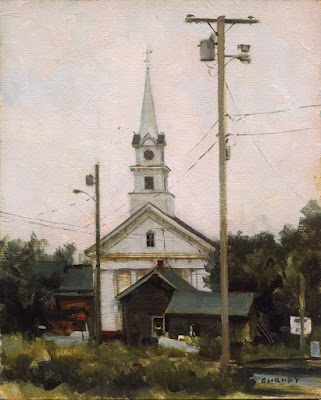



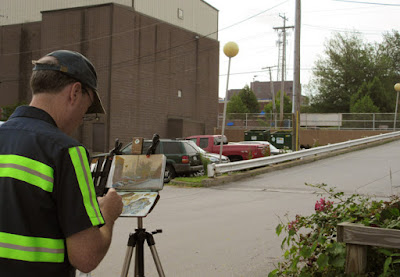


.jpg)
